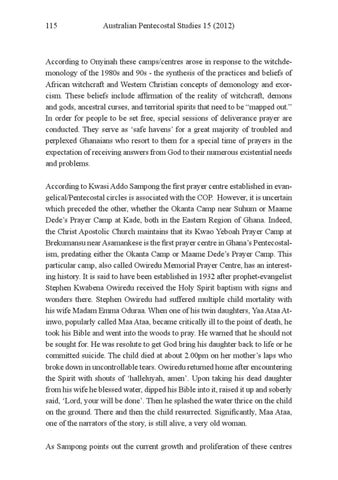115
Australian Pentecostal Studies 15 (2012)
According to Onyinah these camps/centres arose in response to the witchdemonology of the 1980s and 90s - the synthesis of the practices and beliefs of African witchcraft and Western Christian concepts of demonology and exorcism. These beliefs include affirmation of the reality of witchcraft, demons and gods, ancestral curses, and territorial spirits that need to be “mapped out.” In order for people to be set free, special sessions of deliverance prayer are conducted. They serve as ‘safe havens’ for a great majority of troubled and perplexed Ghanaians who resort to them for a special time of prayers in the expectation of receiving answers from God to their numerous existential needs and problems. According to Kwasi Addo Sampong the first prayer centre established in evangelical/Pentecostal circles is associated with the COP. However, it is uncertain which preceded the other, whether the Okanta Camp near Suhum or Maame Dede’s Prayer Camp at Kade, both in the Eastern Region of Ghana. Indeed, the Christ Apostolic Church maintains that its Kwao Yeboah Prayer Camp at Brekumansu near Asamankese is the first prayer centre in Ghana’s Pentecostalism, predating either the Okanta Camp or Maame Dede’s Prayer Camp. This particular camp, also called Owiredu Memorial Prayer Centre, has an interesting history. It is said to have been established in 1932 after prophet-evangelist Stephen Kwabena Owiredu received the Holy Spirit baptism with signs and wonders there. Stephen Owiredu had suffered multiple child mortality with his wife Madam Emma Oduraa. When one of his twin daughters, Yaa Ataa Atinwo, popularly called Maa Ataa, became critically ill to the point of death, he took his Bible and went into the woods to pray. He warned that he should not be sought for. He was resolute to get God bring his daughter back to life or he committed suicide. The child died at about 2.00pm on her mother’s laps who broke down in uncontrollable tears. Owiredu returned home after encountering the Spirit with shouts of ‘halleluyah, amen’. Upon taking his dead daughter from his wife he blessed water, dipped his Bible into it, raised it up and soberly said, ‘Lord, your will be done’. Then he splashed the water thrice on the child on the ground. There and then the child resurrected. Significantly, Maa Ataa, one of the narrators of the story, is still alive, a very old woman. As Sampong points out the current growth and proliferation of these centres
